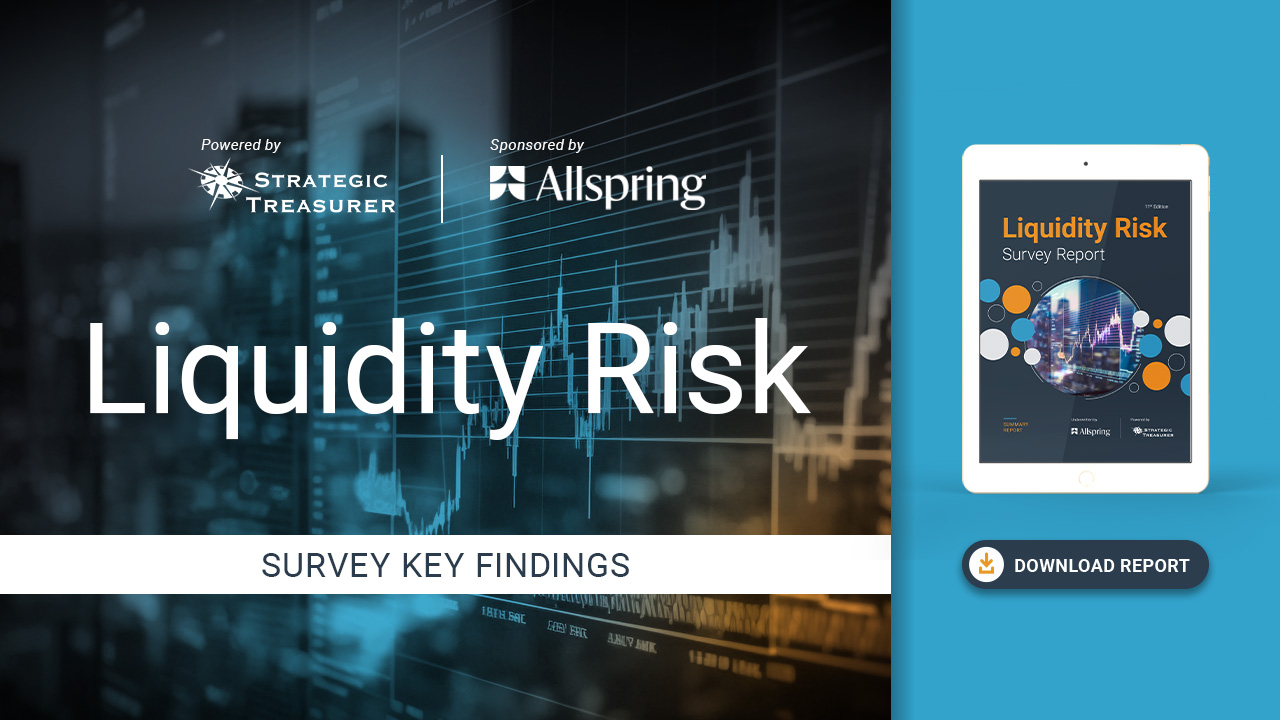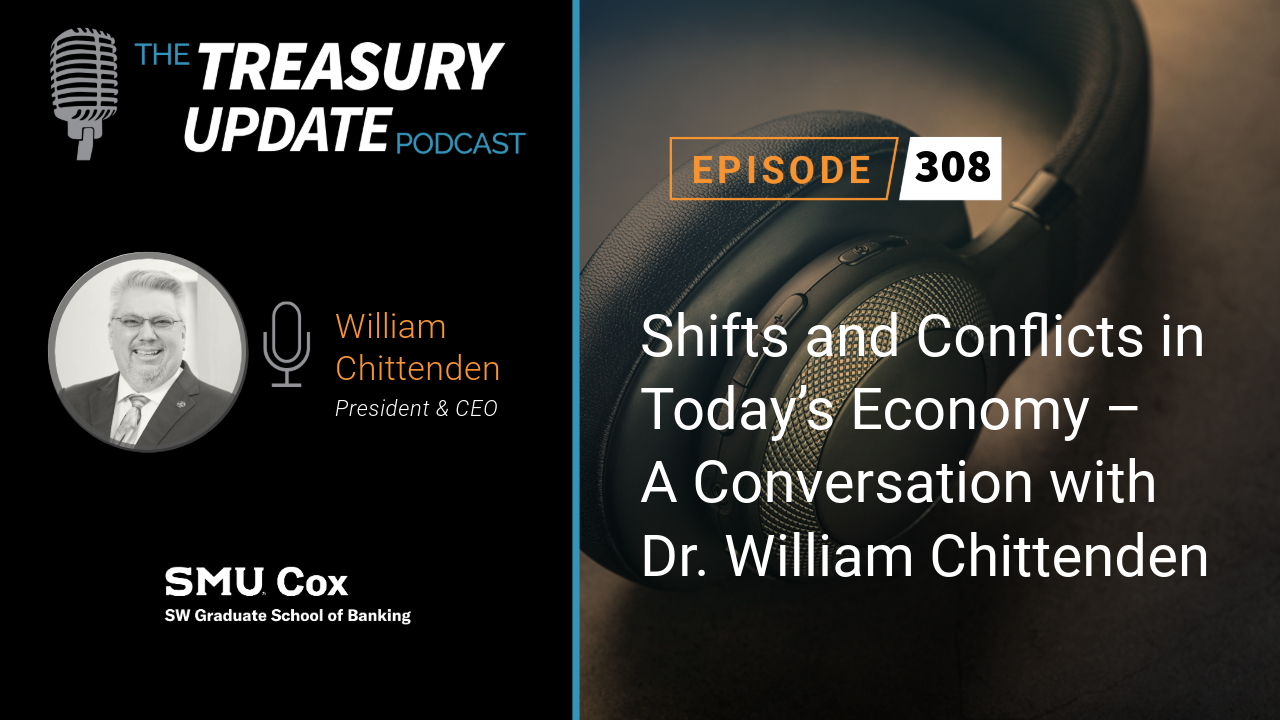
Episode 309
Shifts and Conflicts in Today’s Economy – Part 2: A Continued Conversation with Dr. William Chittenden
In today’s podcast, Dr. William Chittenden, President & CEO of SW Graduate School of Banking, will continue the discussion with a deeper look into critical economic issues. Topics of discussion include debt to GDP, government spending, monetary and fiscal policy. Bill will also cover how this can impact businesses and the overall economy.
Host:
Craig Jeffery,
Strategic Treasurer


Speaker:
Dr. William Chittenden,
SW Graduate School of Banking


Subscribe to the Treasury Update Podcast on your favorite app!
Episode Transcription - Episode # 309: Shifts and Conflicts in Today’s Economy-Part 2 - A Continued Conversation with Dr. William Chittenden
Announcer 00:04
Welcome to the Treasury Update Podcast presented by Strategic Treasurer. Your source for interesting treasury news, analysis, and insights in your car, at the gym, or wherever you decide to tune in.
Craig Jeffery 00:18
Welcome to the Treasury Update Podcast. Today’s episode is a continuation on shifts and conflicts in today’s economy, a conversation with Dr. William Chittenden. Bill, welcome again to the Treasury Update Podcast.
William Chittenden 00:32
Thanks for having me.
Craig Jeffery 00:33
So we went through a lot on the economy, and the next area I wanted to just hear some of your thoughts on is the the magnitude of the national debt, you know, if the US economy is around 28 trillion, it wasn’t that long ago. I remember when we were talking about Italy, not you and I, but the conversation was that, if you get over your debt gets to be over 100% of the gross domestic product. That would become a measure of irresponsibility, or some other terms that were used. So the US has gone past that. We’re not anywhere close to what, let’s say Japan is. But what’s your analysis of where we are in the US, where we’re heading, and what, what, what might this lead to, in terms of the size of the national debt compared to the economy?
William Chittenden 01:19
So real quick, I want to read you a quote from Time magazine. By most measures of private wealth, the US is the world’s richest country, but in terms of its ability to pay for the public services, health care, education, welfare, the country seems almost to be going broke. Can a nation with a trillion dollar economy be running out of money. And what I love most about this quote is it’s from March of 1972 so over 50 years ago, but that could have been written last week in Time Magazine, and our national debt is currently at a little over $34 trillion now. Part of the problem with me saying that that number is folks just can’t comprehend trillions of dollars. So one thing that I usually tell groups to kind of put it in perspective for them is think of it this way. So Craig, let’s say you and your significant other get in an argument and one of you says to the other, I’m not speaking to you for 1 million seconds. That’s about 12 days. And we can appreciate 12 days, but if one of you slips and says 1 billion seconds, that’s about 32 years. Now we can appreciate that difference then between millions and billions, because we can appreciate the difference between 16 days and 32 years. But if you say a trillion that’s 32,000 years, 1 trillion seconds is 32,000 years, we cannot comprehend 32,000 years. That doesn’t mean anything to us. And it’s the same thing, unfortunately, with these numbers, if we’re looking at millions, billions and trillions, it’s hard to comprehend that a trillion is 1000 times more than a billion. And so when we’re talking about $34 trillion one way to look at this is, as you said, as a percentage of GDP. So right now, the debt is 150% of GDP. So as you said, also before, when we’re looking at Italy, when we’re looking at Greece, during the financial crisis, they were well over 100% 110 120 130% of their GDP, and those countries were having difficult conversations, and that the term that was being used was austerity, means we’re going to have to increase taxes, and we’re going to have to cut back on spending in the US. If you go back to the end of the Carter administration, we had less than $1 trillion in national debt. And then as we go through the all the presidency, so this isn’t a particular political party or any one particular president, every president since Jimmy Carter, and really before that. The last time we had this as a side note zero national debt is when Andrew Jackson was president, because he hated having debt. And so there was a year where the national debt was paid off. And then guess what happened? The next year we had more national debt, but it’s gone from under a trillion dollars to $34 trillion and again, it’s both political parties that are responsible for it. It nearly tripled. Under Ronald Reagan, went from 2.6 to $4 trillion under Bush, 41 went to about 5.8 trillion. Under Clinton, didn’t quite double. Under. Bush, 43 went to 10 point 7 trillion. Again, nearly doubled under the Obama administration right at $20 trillion increased nearly $28 trillion during Trump’s four years, and then we’ve increased another $6 trillion or so in the first three years of the Biden administration. Through the end of 2023, again, we were right at $34, trillion in national debt. Now another way of looking at this is, of course, we’ve got a bigger population today than we did when Jimmy Carter was president, and we’ve had a lot of inflation since Jimmy Carter was president. So if you adjust it for inflation and put it on a per capita basis, it was about $12,000 for every man, woman and child in America in terms of our national debt under Jimmy Carter, I’m not going to go through all the intermediate presidents, but it’s now at $86,000 per man, woman and child that’s been adjusted for inflation. And so there is nearly eight times as much national debt per woman, man, woman and child in the United States today than there was in 1980 why? Because we continue to spend more than we bring in. You know, we had, I believe it was two years during the Clinton administration where we actually ran some surpluses. Not that that went away, but that that went down just a hair during those two years. But still, even with those two years of surplus, if you look at the entire Clinton administration, national debt still went up. Why? Just looking at the actual numbers for fiscal year 2023 so that would have ended in October of 2023 we brought in about $4.4 trillion in taxes and spent $6.1 trillion in various government spending. That’s $1.7 trillion in just a single year that we had in terms of our deficit, the forecast by the Congressional Budget Office between now and 2034 is that the annual deficit so that difference between spending and taxes is going to be almost $2.6 trillion and between now and 2034 we’re going to increase the national debt in other $20 trillion we’re already at 150% of GDP. This is an unsustainable course. We cannot continue to do this.
Craig Jeffery 07:38
So Bill, as we look at the, you know, the percentage of debt over GDP. I know there’s a couple different kinds of GDP. There’s whatever the actual gross domestic our total economy currently, and there’s an adjusted economy. So can you talk through that in terms of how people look at the percentages off of that?
William Chittenden 07:58
Sure. So if we’re looking at what we call nominal GDP, which includes not only the number of goods and services that we produced in the US, but also takes into account any increases in the prices on those that’s what we call nominal GDP. That’s at about $28 trillion and so if we compare that to our national debt, we’re at about 120% of GDP in terms of our nominal GDP. If we look at real GDP, where we’ve taken out that impact of inflation, that’s where we’re right at about 150% others would also argue that there’s more liabilities that the government has that’s not reflected in those debt numbers right now and again. That’s another whole conversation in terms of, you know, how much is really owed, in terms of future social security payments and those types of things. And you know the point is, is that every single year, we’re spending more and more than we bring in in taxes, no matter how you measure it, the national debt is growing faster than our economy is growing. That’s not a good thing. Every year it becomes a larger and larger proportion of our economy. Again, the CBO is forecasting that just the interest on the national debt will be about 16% of all federal expenditures. Imagine that 16% of everything that the government spends money on will simply be the interest on the national debt if we continue on this path right now, it’s a little over 10%.
Craig Jeffery 09:40
You know, as you look at the debt and how that continues to absorb more of the the revenue of that the government takes in, we have a couple things on the monetary policy and the fiscal policy side that tend to be in conflict. Why is that? What do you think about that from an economist standpoint?
William Chittenden 09:58
Yeah. Well, the monetary policy, of course, as we’ve talked about, is administered by the Federal Reserve, and they’ve got a legislative mandate. They’re mandated to have stable prices and full employment, and that’s what the Fed has to focus on Congress, who controls the purse strings. And again, I’m a little bit cynical here, but I am an equal opportunity cynic when it comes to either political party in terms of doing the right thing economically, because they’ve failed to show that they can do that, but their number one priority is to get reelected. And so how do you get reelected? Well, you promise, folks, if you’re from a particular political party, I’m going to cut your taxes. And if you’re from the other political party, your promise is, I’m going to increase spending. I’m going to spend more on all of these other programs, and both parties get what they want. And if we spend more and continue to tax less, then we continue to have greater and greater deficits, and eventually, just like anyone else, you’re going to run out of credit that you can use. What’s the benefit of that? The benefit of all of this deficit spending is it stimulates the economy. Typically, that wouldn’t be a bad thing. But what is the Federal Reserve trying to do right now? The Federal Reserve is trying to slow down the economy to get this inflation under control. We don’t need more economic activity from the central government, because that helps inflation. It causes more inflation, I should say so you’ve got monetary policy trying to slow the economy down. We keep talking about the soft landing that we might actually achieve, and you’ve got the central government saying, Let’s spend more, spend more, spend more and grow the economy faster than what it’s been growing at. So if I had to place my money on either of those groups, I would place it again, a bit biased, but with the economists that are focused on stable prices and full employment rather than what’s going to get the voters attention. Because the solution is not complicated. The solution is we need to spend less and we need to tax more. Now, nobody likes either of those. Again, it’s not complicated, but I’m not saying it’s it’s easy, but it’s not that complicated. Again, it’s addition and subtraction.
Craig Jeffery 12:19
Yeah, the math isn’t complicated. The, like you said, the repercussions and the the fight that’ll that’s part of it will be significant. Yeah, thanks for, Thanks for stepping through that. You know, what are the just kind of as a as a summary and, you know, final thoughts, what are, what are some of the implications on businesses for what we’ve talked about over the last two podcasts, levels of inflation, good employment, some of the fiscal, monetary policy things what? What are some of the implications on businesses that you see?
William Chittenden 12:52
On the fiscal policy side, again, the positive is this deficit spending that we’ve been doing does contribute to economic growth, and so if the government spends less, will have a slowing effect on the economy. So that’s not a good thing. However, the more the government borrows, the more you have of what’s referred to as that crowding out effect. You know, there’s literally so many dollars out there in the world to invest, and if the government is sucking up more and more of that, that leaves less dollars for businesses to borrow. And so that’s going to lead to higher interest rates, at least longer term rates, as businesses and government fight for those limited, investable dollars that are out there. So I think that’s the real danger of, again, us not doing anything and continuing on this path, is when we do decide that we need to slow things down, rather than it being gradual, it’s going to be slamming on the brakes, and we will be having those discussions of austerity that we saw what 15 years ago, over in Greece and Italy, here in the US, we think, Well, no, we’ll never have that. We’re on a path, unfortunately, where that could happen. I don’t know what that tipping point is. Is it 120% is it 150 Is it 200% again? I don’t know, but I do know that spending continues to grow faster than revenues, and that’s not something that continue forever. Just think of your own personal finances. You have the ability to borrow. And during bad times, we understand that we might have to draw down on our savings, or we might have to borrow, but we also understand during the good times, what do we do? We pay back what we borrow during the bad times. The government doesn’t do that during bad times, they borrow to get us through the bad times. And then during the good times, they borrow even more. They go, Well, look how great things are. And all it does is it means that national debt continues to go up, and regardless of how you measure it. It’s growing faster and faster. And again, there’s, there is some limit. It can’t continue to grow where it takes up the entire economy, for example.
Craig Jeffery 15:09
And while Japan is, I think, a little over, Are they over 200% they’ve been able to hold, you know, rates down so low, which I guess, buys you more time. But even they’ve had to adjust their rates on the central bank side so.
William Chittenden 15:25
Well, and I don’t think anybody would want to trade our economy for the Japanese economy, at least not over the last 10, 15, years. You’re right. You know, they kept rates low and we kept rates low for a very long time. I think the mistake on keeping rates at zero for so long, it was great for the borrower, but they completely forgot the saver. And so again, all those retirees, they didn’t have money to spend, because, again, their their interest income on their retirement portfolio went to almost zero. And it’s, it’s a two sided market. And so if you forget about the investors, you forget about the savers. Rates are at zero. They have no income and they can’t spend. There’s very little incentive on the other side then for folks to borrow and, you know, invest in new products and infrastructure, etc, the folks on the other side can’t earn anything to spend it on.
Craig Jeffery 16:19
Excellent. Thanks. Thanks, Bill. I really appreciate all your comments on both these podcasts.
William Chittenden 16:24
Thank you for having me and allowing me to at least share my thoughts on these things. You can tell I can talk literally all day on this stuff.
Announcer 16:36
You’ve reached the end of another episode of the Treasury Update Podcast. Be sure to follow Strategic Treasurer on LinkedIn, just search for Strategic Treasurer. This podcast is provided for informational purposes only, and statements made by Strategic Treasurer LLC on this podcast are not intended as legal, business, consulting, or tax advice. For more information, visit and bookmark StrategicTreasurer.com.
Related Resources
Payment Security & Fraud Prevention The Principles of SECURE CLAMPS
This book brings you twelve payment security principles, distilled from one portion of Strategic Treasurer’s SecureTreasury™ course. The cores of these twelve foundational principles for securing your payment processes remain consistent amidst constantly evolving threats and leading practices.
Shifts and Conflicts in Today’s Economy
In today’s podcast, Dr. William Chittenden, President & CEO of SW Graduate School of Banking, will discuss a Harris Poll showing that 55% think the economy is shrinking, 56% believe the US is in a recession, 49% think the S&P 500 is down, and 49% believe unemployment is at a 50-year high. Dr. Chittenden will clarify the economic statistics and explore why these misconceptions exist, covering topics such as inflation, employment, interest rates, and the US national debt.







